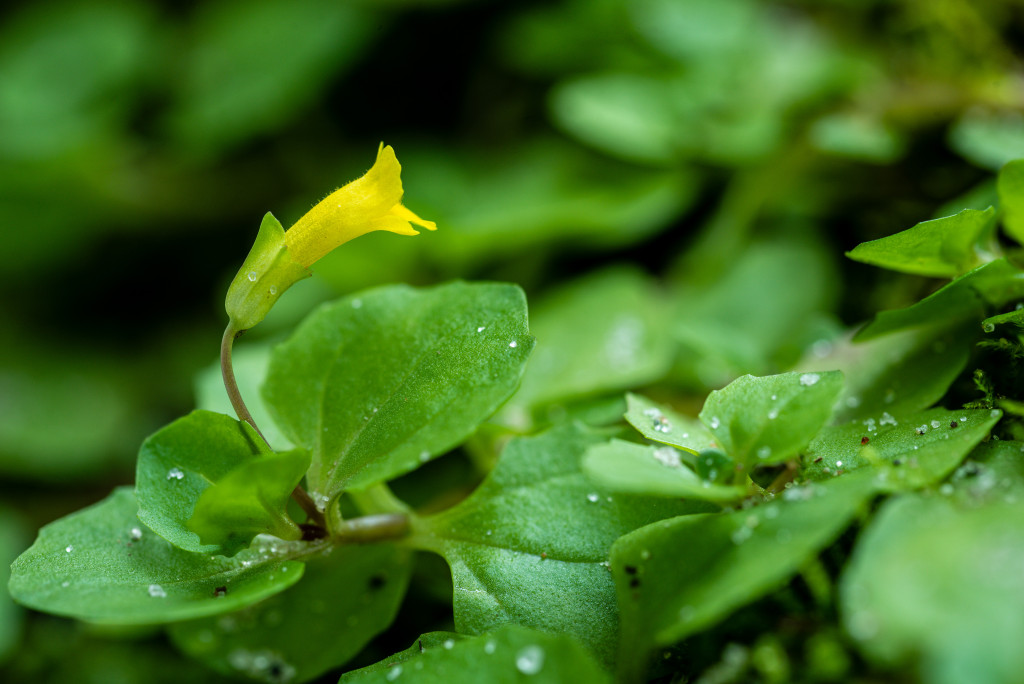
By Gerry Steinauer, Botanist
To find roundleaf monkey-flower (Mimulus glabratus), do not look high in the trees. Instead, head to the cold, clear water streams of central and western Nebraska. The plant’s favorite haunts include the slow shallows of spring-fed Sandhills streams and the sandy-bottomed pools of spring-branch canyon streams flowing into the central Niobrara River. Avoid streams where agricultural runoff has muddied the waters: You will be hard pressed to find it there.
Often growing partially submerged in water, roundleaf monkey-flower has creeping stems that form loose colonies. During summer, each leaf cluster sprouts a lone stalk topped by a single, yellow flower. The flowers, and those of other monkey-flowers, have five fused petals that form an upper and lower lip.
To 16th century Swiss botanist Carl Linnaeus, the lips formed a smile or grin, so he named the genus Mimulus, from the Latin word mimus, meaning “grinning comic actor.” More fertile imaginations saw within the flowers the face of a monkey, especially when pinched from the sides. Thus, the common name monkey-flower.
While there are more than 100 annual and perennial species of Mimulus known worldwide, only four perennials grow in Nebraska.
Though widespread throughout the western United States and Canada, the yellow-flowered common monkey-flower (M. guttatus), despite its name, is uncommon in our state. The plant has been collected from stream shallows in Dundy, Keith and Garden counties and may occur elsewhere in southwestern Nebraska, although groundwater pumping has reduced stream flows and has likely caused its decline. Common monkey-flower can be distinguished from roundleaf monkey-flower by the reddish-brown spots on its lower lip and upright growth form.
Nebraska’s two blue- to purple-flowered Mimulus are sharp-wing monkey-flower (M. alatus), which inhabits streambanks and seeps in our far southeastern woodlands, and Allegheny monkey-flower (M. ringens), a common plant of eastern and northern Nebraska streambanks, seeps, low woodlands, sandbars and wetland fringes. These two robust, colony-formers are similar in general appearance, but are easily distinguished by sharp-wing’s stalked leaves compared to Allegheny’s stalk-less leaves.
Native Americans once used monkey-flowers as food and medicine. Several tribes ate the stems and leaves of our yellow-flowered species fresh and boiled. The Shoshoni applied the crushed leaves of common monkey-flower to soothe wounds and rope burns. The Iroquois made a decoction of Allegheny monkey-flower roots as a wash to counteract poisons.
Today, wildflower enthusiasts are less familiar with the monkey-flowers, as well as other wetland wildflowers, than they are with prairie and woodland wildflowers. This could be because they rarely venture to areas where their feet might get wet. But now that you are familiar with monkey-flowers, perhaps it is time to seek them out. Do not worry: Your shoes will dry.
An Escaped Monkey-flower
By Gerry Steinauer, Botanist
In the early 19th century, common monkey-flower from North America was introduced to Europe, where it escaped from water gardens into the wild. Without the checks of its North American pests and diseases, it ran rampant in areas of soggy soils, displacing native plants. Plainly, Americans are not the only ones that introduce non-native plants that lead to ecological and, sometimes, economic boondoggle.
Sadly, we continue these introductions for various and often dubious reasons: as “beautiful and hardy” landscaping flowers and shrubs; protein- and mineral-rich legumes “guaranteed to grow trophy bucks”; or gigantic grasses to produce “environmentally-friendly” ethanol. Almost always, native plants can fill these same roles.
While the promoters of these non-natives hope to line their pockets, it is poor Mother Nature who suffers, as well as the landowners and county governments who spend millions attempting to eradicate these invaders from roadsides, pastures, woodlands, wetlands and crop fields. When will we learn?
